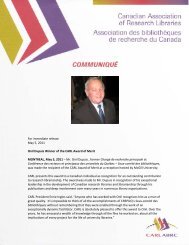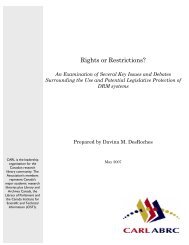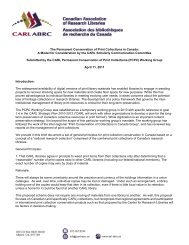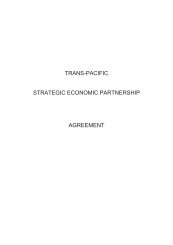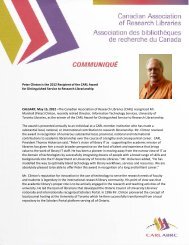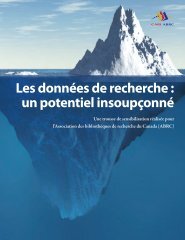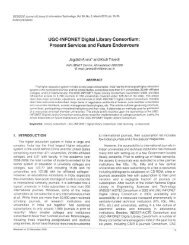PDF - CARL - ABRC
PDF - CARL - ABRC
PDF - CARL - ABRC
Create successful ePaper yourself
Turn your PDF publications into a flip-book with our unique Google optimized e-Paper software.
Special Collections in ARL Libraries<br />
March 2009<br />
that they often complement. This section of our report alludes to some ways in which these new types of collections are<br />
developing now.<br />
Models of How to Handle Digital Materials in Special Collections<br />
The growing proportion of born-digital materials in special collections will shift the focus of digital curation from ad hoc,<br />
focused efforts for the occasional digital accession to established policies, procedures, and workflows that can manage<br />
these materials routinely. Organizations increasingly are experiencing pressure to muster the financial, administrative, and<br />
technical resources that such standardized practices require.<br />
Special collections practices until now have tended to be shaped by an approach that privileges the unique needs of<br />
each body of materials rather than standardized, production-oriented processes that allow for their expeditious handling.<br />
Just as the level of customized work on traditional formats is being replaced by “processing light” and similar approaches,<br />
digital materials require a similar approach that emphasizes expeditious availability along with long-term stewardship.<br />
The United States National Archives and Records Administration (NARA) is providing helpful guidance for the rest of the<br />
community in this sphere. 35 There is also much to be learned from litigation support and computer forensics technology. 36<br />
There is a well-established set of core functional activities for managing and appraising special collections, including<br />
accessioning, physical management and preservation, description, and access. The OAIS reference model, 37 for example,<br />
provides a framework that mirrors these traditional functions in a digital environment and institutions with a responsibility<br />
for special collections need to respond to the need for each of them. To a degree not present in the analog environment,<br />
participation in the evolution of information recording technologies and collaboration with creators and service providers<br />
is essential to effective curation of digital materials. 38 Both the inherent stability of many analog media (especially ink<br />
on paper) and the ability of creators and service providers to manage them with little technical expertise or concern for<br />
long-term preservation and access are absent for digital materials. Early intervention and deep technical knowledge and<br />
skills are required in ways that most special collections repositories have not been attuned to or organized for. Even if<br />
repositories develop new approaches and capabilities in-house, the dynamic nature of digital materials requires effective<br />
partnerships with others, especially including information technology specialists. Case studies are needed to illustrate<br />
possible approaches and to help individual repositories avoid the thankless work of reinventing solutions in isolation. 39<br />
35 See, for example, “Strategy for Digitizing Archival Materials for Public Access, 2007–2016” http://www.archives.gov/digitization/strategy.<br />
html and “Lifecycle Data Requirement Guide” found at http://www.archives.gov/digitization/guidance.html.<br />
36 See, for example, “Adapting Existing Technologies for Digitally Archiving Personal Lives” in which Jeremy Leighton John addresses the<br />
relevancy of existing technologies in computer forensics to the needs of digital curation http://www.bl.uk/ipres2008/presentations_day1/09_<br />
John.pdf. Strategies for recovering digital works so that they can be preserved are explored in “Finding and Archiving the Internet Footprint” by<br />
Simson Garfinkel and David Cox http://www.simson.net/clips/academic/2009.BL.InternetFootprint.pdf.<br />
37 The Consultative Committee for Space Data Systems’ recommendation for the OAIS reference model is available at http://public.ccsds.org/<br />
publications/archive/650x0b1.pdf.<br />
38 Illustrations of effective, early partnerships with creators of digital content include the sustained conversations between expected donors<br />
of personal papers, such as elected officials or authors, and curators to discuss and influence the scope and organization of the materials to be<br />
deposited.<br />
39 The work of the National Digital Information Infrastructure and Preservation Program (NDIPP) promises useful case studies in this area.<br />
Included in the sixty-seven partners (as of March 2007) are eight consortial partnerships comprising thirty-three institutions that are selecting,<br />
collecting, and preserving specific types of digital content. For an example of a significant attempt to capture born digital resources, in this case<br />
the Web, see the Internet Archive http://www.archive.org.<br />
Page 26 www.arl.org/bm~doc/scwg-report.pdf



